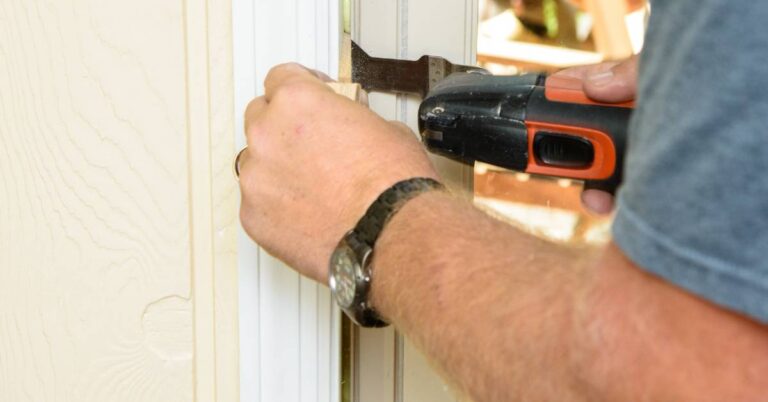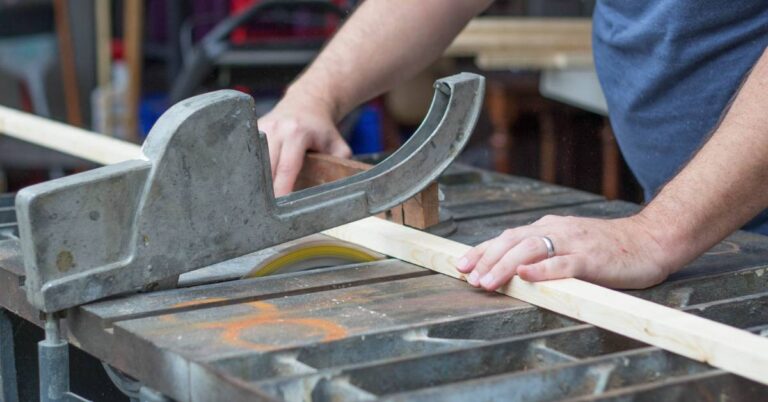Grinder vs Oscillating Tool: Choosing the Right Power Tool for Your Project
Grinders and oscillating tools are essential for DIY enthusiasts and professionals. Both offer unique capabilities for cutting, sanding, and shaping various materials. Grinders excel at rapid material removal and cutting through rigid surfaces, while oscillating tools provide precision and versatility for detail work.
These tools serve different purposes in a workshop or job site. Grinders are robust machines designed for heavy-duty tasks such as cutting metal or masonry. On the other hand, oscillating tools specialize in intricate work like flush-cutting, plunge-cutting, and accessing tight spaces.
Depending on the project requirements, a grinder or an oscillating tool should be chosen. Grinders are ideal for large-scale material removal and rough cuts. Oscillating tools shine when precision and control are paramount, especially in finished work or delicate applications.
Key Takeaways
- Grinders are best for heavy-duty cutting and material removal
- Oscillating tools excel in precision work and tight spaces
- Tool selection depends on project requirements and desired outcomes
Overview of Grinder and Oscillating Tool Capabilities
Grinders and oscillating tools serve distinct functions in DIY and professional projects. These power tools differ in their design, applications, and operational mechanisms.
Distinct Purposes of Grinders and Oscillating Tools
Angle grinders excel at cutting, grinding, and polishing hard materials. They’re ideal for metalwork, masonry, and concrete. With their rotating discs, angle grinders can quickly remove material or create clean cuts.
Oscillating multi-tools are versatile instruments for precision work. They excel at flush-cutting, sanding in tight spaces, and detail work. With their back-and-forth motion, these tools can handle wood, drywall, and softer metals.
Grinders are best for heavy-duty tasks while oscillating tools shine in intricate applications. The choice between them depends on the specific job requirements.
Key Features and Power Source Variations
Angle grinders typically have more powerful motors, ranging from 4 to 15 amps. They operate at high speeds, often between 5,000 to 10,000 RPM. Most models are corded for consistent power.
Oscillating tools have lower power ratings, usually 2 to 5 amps. They operate at lower speeds but with higher frequency oscillations. Many models come in both corded and cordless versions.
Grinders use various disc attachments for different tasks. Oscillating tools employ a wide range of blades and accessories. This versatility makes the oscillating multi-tool a popular choice for home improvement projects.
Both tools offer variable speed settings. This feature allows users to match the tool’s performance to the material and task.
Comparative Analysis of Functionalities
Grinders and oscillating tools offer distinct capabilities for various tasks. Their features and performance differ significantly in cutting, sanding, and precision work.
Cutting and Grinding Versatility
Grinders excel at cutting and grinding metal. They use abrasive discs to slice through thick materials or remove excess metal quickly. Grinders can easily cut rebar, pipes, and sheet metal.
Oscillating tools offer more diverse cutting options. They use toothed blades for wood, plastic, and soft metals. These tools can make plunge cuts and perform flush cutting against surfaces.
Both tools are used in tile work. Grinders with diamond blades effectively cut tiles, while oscillating tools with carbide blades handle precision cuts around fixtures.
Sanding and Polishing Proficiency
Grinders shine in heavy-duty sanding and polishing tasks. They rapidly smooth welds and remove rust from metal surfaces. With the right attachments, grinders can polish cars and buff stone countertops.
Oscillating tools provide finer control for sanding. They work well on wood, removing paint and smoothing drywall joints. Their compact design allows access to corners and edges.
Both tools can use various grit levels for different finishes. Grinders cover larger areas faster while oscillating tools offer more precision on smaller surfaces.
Precision Work and Tight Spaces Accessibility
Oscillating tools excel in precision work and accessing tight spaces. Their small, triangular sanding pads reach into corners and along edges. These tools can make accurate cuts in confined areas, such as removing grout or trimming door jambs.
Due to their circular design, grinders are limited in tight spaces and struggle with intricate cuts and detailed work.
Oscillating tools offer superior control for tasks requiring finesse. They can carefully remove material without damaging surrounding surfaces, making them ideal for delicate restoration work and detailed craftsmanship.
Assessment of Attachments and Accessories
Attachments and accessories greatly expand the capabilities of grinders and oscillating tools, impacting functionality, versatility, and long-term performance.
Diversity of Attachments for Enhanced Functionality
Grinders offer a wide range of attachments. Cutting discs allow precise slicing through metal and masonry. Grinding wheels shape and smooth various materials. Wire wheels effectively remove rust and paint.
Oscillating tools feature an even broader selection. Blades accurately cut wood, metal, and plastic. Sanding pads smooth surfaces in tight spaces. Scraper attachments remove adhesives and old paint.
Both tools utilize quick-change systems for rapid attachment swaps. This enhances efficiency during multi-step projects. Some attachments are interchangeable between brands, increasing flexibility.
Maintenance and Durability Considerations
Proper care extends the attachment lifespan. Regular cleaning prevents buildup that can reduce effectiveness. Sharpening blades and replacing worn sanding pads maintain optimal performance.
Durability varies by attachment type and quality. Premium attachments often last longer but cost more upfront, while budget options may require more frequent replacement.
Storage impacts longevity. Keeping attachments in protective cases prevents damage. Organizing by type and size improves efficiency.
Safety is crucial when handling attachments. Worn or damaged accessories pose risks. Regular inspection helps identify potential hazards before use.
Safety and Operational Differences
Grinders and oscillating tools differ significantly in their safety considerations and operational characteristics. These differences impact protective measures, handling techniques, and debris management.
Protective Measures and PPE
Grinders generate sparks and debris, requiring robust eye protection such as safety goggles or face shields. Users should wear heavy-duty gloves to guard against flying particles and potential contact with the spinning disc. Hearing protection is essential due to the high noise levels produced by grinders.
Oscillating tools generally create less debris and operate more quietly. Safety glasses are typically sufficient for eye protection. Light gloves provide adequate hand protection for most oscillating tool tasks. Hearing protection may be necessary for extended use or when working with certain materials.
Device Handling and Debris Management
Due to their rotational force, grinders demand a firm grip and careful control. Users must maintain steady pressure and movement to prevent kickback or loss of control. Debris from grinding operations can be extensive and widespread, requiring proper workspace preparation and cleanup procedures.
Oscillating tools offer more precise control with less physical effort. Their back-and-forth motion reduces the risk of sudden movements or loss of control. Debris production is usually localized, making containment and cleanup easier. Users should be cautious and maintain a clear work area to prevent accidents.
Both tools require proper stance and grip to ensure safe operation. Regular maintenance checks are crucial to prevent equipment malfunction and ensure optimal performance.
Economic Aspects and Professional Usage
Grinders and oscillating tools play crucial roles in construction and renovation projects. Their economic impact and usage patterns differ for professionals and DIY enthusiasts.
Cost-Benefit Analysis for Construction Projects
Grinders offer high-speed material removal at a lower initial cost. Their robust design suits heavy-duty tasks in construction and demolition. Replacement discs are inexpensive, contributing to long-term savings.
Oscillating tools have a higher upfront price but provide versatility. Their multi-functional nature reduces the need for multiple specialized tools. This can lead to overall cost savings on larger projects.
Grinders often prove more economical for large-scale operations due to their speed and durability. Oscillating tools shine in precision work and tight spaces, potentially saving time and labour costs in intricate projects.
Tool Selection for Professionals and DIY Enthusiasts
Construction and remodelling professionals typically invest in grinders and oscillating tools. Grinders excel at tasks like cutting rebar and removing excess concrete while oscillating tools are preferred for detail work such as trimming door frames or making plunge cuts.
DIY enthusiasts often start with an oscillating tool due to its versatility. It handles a wide range of home improvement tasks without requiring multiple purchases. As projects grow in scope, many add a grinder to their toolkit for more demanding applications.
Tool rental services offer both options, allowing users to test before buying. This helps make informed decisions based on specific project needs and budget constraints.
Conclusion
Grinders and oscillating tools serve distinct purposes in the workshop. Grinders excel at heavy material removal and cutting tasks. Their powerful motors and abrasive discs make quick work of metal, concrete, and other rigid materials.
Oscillating tools offer unmatched versatility for detail work and tight spaces. Their interchangeable attachments allow for cutting, sanding, scraping and more in hard-to-reach areas.
For most DIYers and professionals, owning both tools is ideal. A grinder handles the big jobs, while an oscillator tackles precision tasks. Those on a budget may prioritize based on their most common projects.
Grinder suit users frequently work with metal or do demolition. Oscillating tools benefit those focused on woodworking, drywall, or home renovations.
Ultimately, the choice depends on individual needs and project types. Both tools have their strengths. Careful consideration of intended uses will guide shoppers to the right option for their toolbox.




